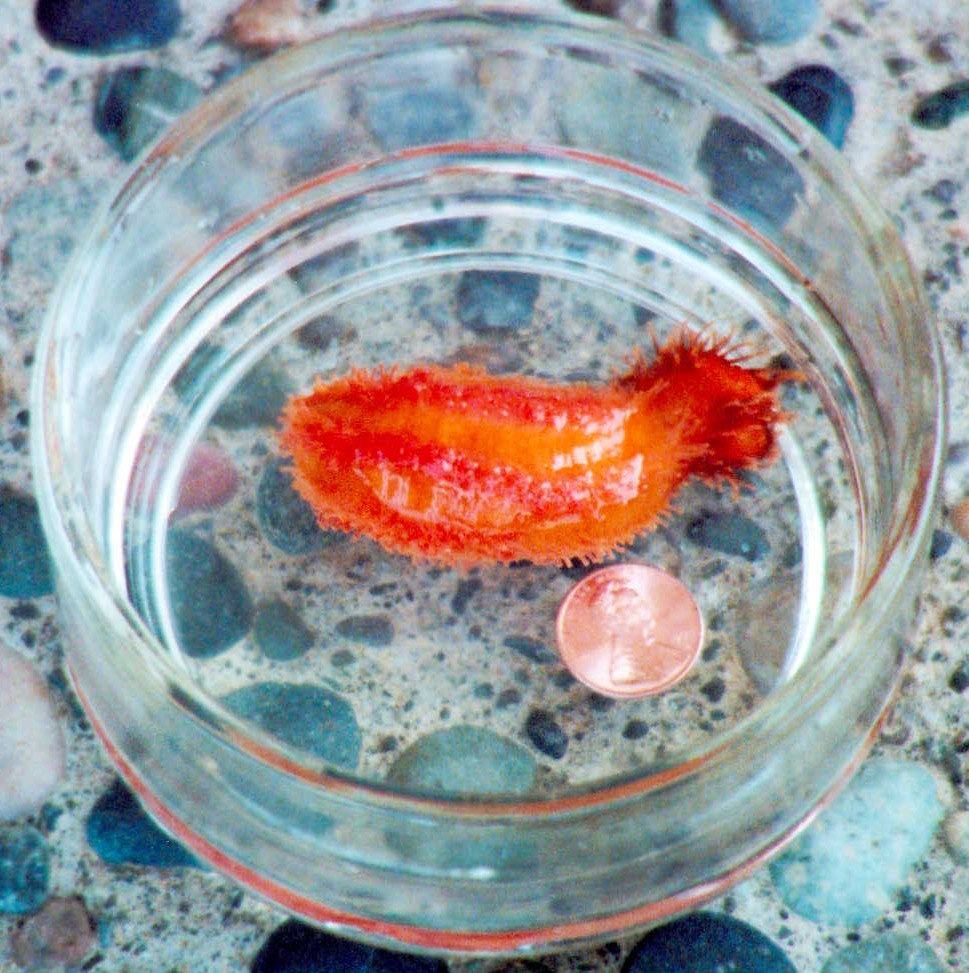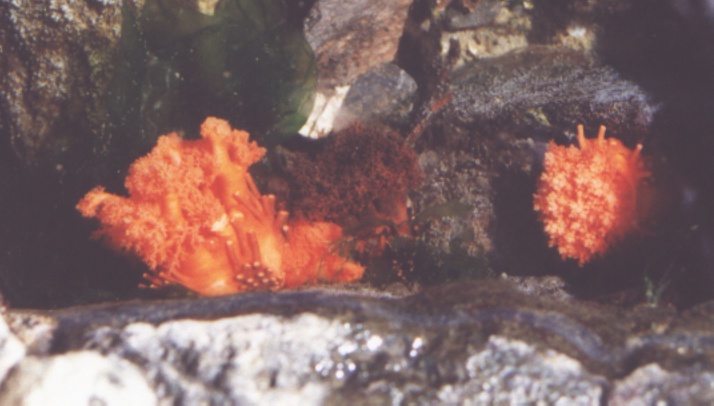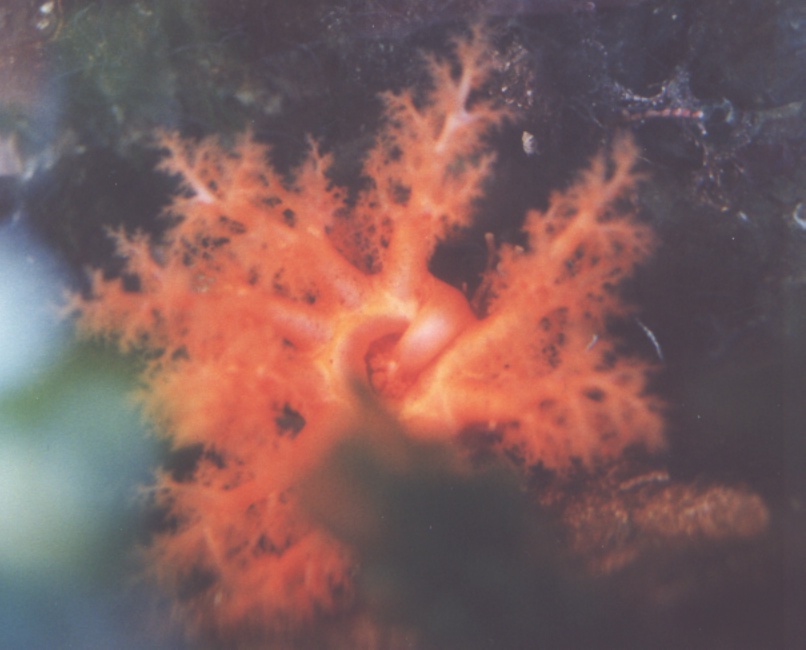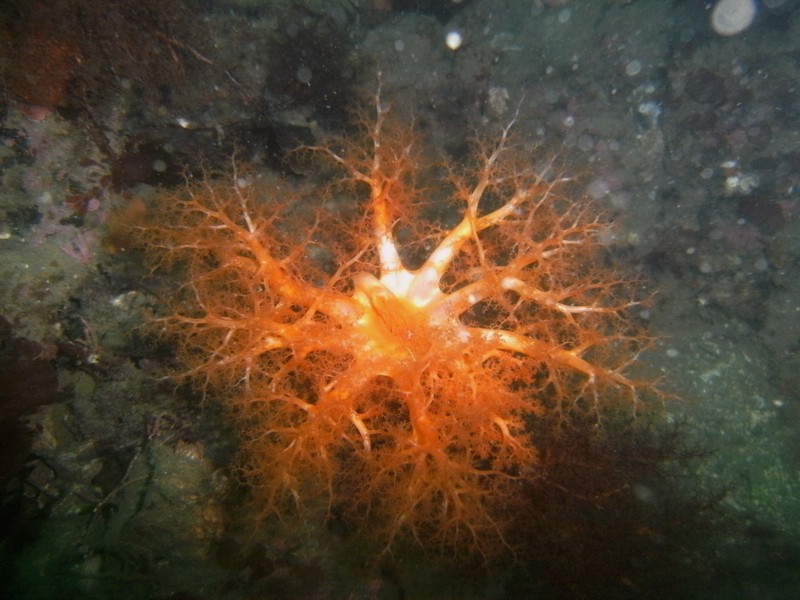Cucumaria miniata (Brandt, 1835)Common name: Orange Sea Cucumber, red sea cucumber, vermilion sea cucumber, red sea gherkin |
|
| Synonyms:
Cladodactyla miniata, Stereoderma miniata, Cucumaria japonica, Cucumaria albida |
 |
| Phylum Echinodermata
Class Holothuroidea Order Dendrochirotida Family Cucumariidae |
|
| Found on Sares Head, WA. Side view. Animal is approx. 10cm in length. | |
| Photo by: Kelly Williams, June 2002 | |
How to Distinguish from Similar Species: Cucumaria pallida is of similar size and feeds in a similar manner but it has white oral tentacles.
Geographical Range: From Sitka, Alaska to Monterey Co., California
Depth Range: Low intertidal to 100m deep
Habitat: In cobble and rocky areas, living between rocks and in crevices.
Biology/Natural History: C. miniata uses its oral tentacles to trap small organisms and detritus suspended in the water. Undisturbed animals may have the body curved into a U shape, so that both the mouth and anus are exposed to moving water. The tentacles can retract rapidly if disturbed. C. miniata is predated on by the sea stars Dermasterias imbricata, Solaster stimpsoni, and S. endeca. Kelp greenling fish sometimes nip the oral tentacles. Tests have shown that neither the body wall nor the viscera are toxic to fish. Eggs, embryos, and larvae are orange in color. The larvae have been found in the plankton of the Puget Sound during the months of March and April.
This species sometimes contains an internal parasitic
gastropod, Thyonicola
dogieli, which appears as a coiled, egg-filled tube.
| Return to: | |||
| Main Page | Alphabetic Index | Systematic Index | Glossary |
References:
Dichotomous Keys:
Carlton, 2007
Kozloff, 1987
General References:
Lamb
and Hanby, 2005
Lambert,
1997
Morris,
Abbott, and Haderlie, 1992.
Kozloff,
1993.
Sept,
1999.
Scientific Articles:
Emlet, Richard B., 1994. Body forms and patterns of ciliation in nonfeeding larvae of echinoderms: functional solutions to swimming in the plankton? American Zoologist 34: pp. 570-585
Knott, K. Emily, and Gregory A. Wray, 2000. Controversy and consensus
in Asteroid systematics: new insights to Ordinal and Familial
relationships. American Zoologist 40:3 pp. 382-392
McEdward,
Larry R. and Benjamin G. Miner, 2006. Estimation
and interpretation
of egg provisioning in marine invertebrates. Integrative and
Comparative
Biology 46:3 pp 224-232
General Notes and Observations: Locations, abundances, unusual behaviors, etc.:

Some individuals in a tide pool, wedged between rocks as
usual.
Photo by Dave Cowles, June 1995.
Width of animal is approximately 7 cm.

Here an individual is stuffing one of its oral tentacles into its
mouth.
Photo by Dave Cowles, June 1995

Another
individual feeding at about 15 m depth off Sares Head, 2014.
Notice that a darker-hued individual is in the shadow at the
bottom right of the photo.
Click HERE for a video of feeding, taken by Brian Watkins 2020.

This photo shows the animals extended underwater. Note the
two
colors of oral tentacles. Underwater photo by Jim Nestler,
July 2005
Authors and Editors of Page:
Kelly Williams (2002): Created original page
Edited by Hans Helmstetler 12-2002, Dave Cowles 2005